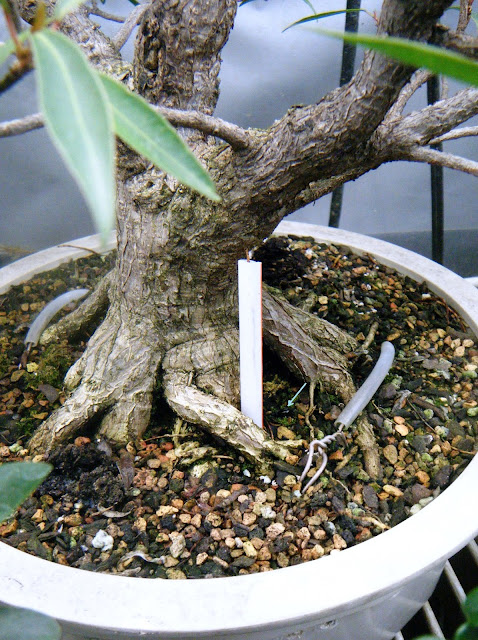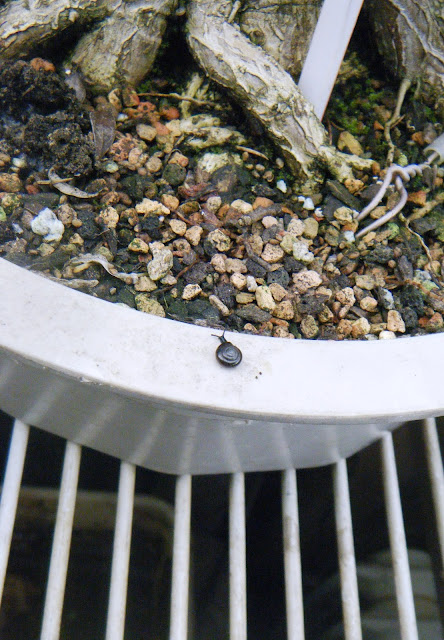The winter conditions that my tropical trees have in the Crate are of course different from summer conditions outdoors. The two biggest differences are that the light is less intense, tho still adequate for growth; and I keep the humidity a good deal higher. Both those factors encourage aerial roots.
If there is a consistently reliable way to induce a tree to throw an aerial root at a particular point, I don't know what it is. As a rule, the tree initiates a new aerial root somewhere that seems good to it, and the grower has to be ready to encourage and protect the ones that happen to appear where the human wants them!
For any who may not know, one common way to protect a new aerial while it extends down to the soil is to place a piece of drinking straw where the root can follow it down. This maintains high humidity right around the root and serves as a warning to the grower: "Caution! Don't bump!" Since aerial roots are very fragile until they anchor and start to lignify, such reminders are very useful.
A couple of weeks ago one of my willow-leaf figs (Ficus salicaria) initiated a new aerial root very close to a point where I'd been hoping for one. I positioned a piece of drinking straw to protect and guide it, and after a few days noticed that the growing root (which has now reached the soil surface) is visible thru the plastic. I decided to take a few pictures tonite.
You'll notice a light-blue arrow to the right of the straw. That points to a snail; more on it in a moment.
This is the fifth snail of this species that I've found around the roots of this willow-leaf within the last two weeks. Snails also find the high humidity and less-intense light in the Crate congenial. But since they feed on living plant tissue as well as dead, I remove them.
While I disposed of another (sixth) snail I noticed, this one poked out its head and started for home. I don't know how it knew which direction to go. Perhaps it could smell the tree; perhaps it sensed the humidity in the substrate; perhaps it detected the shadows among the roots. I'm afraid it didn't get very far.
If there is a consistently reliable way to induce a tree to throw an aerial root at a particular point, I don't know what it is. As a rule, the tree initiates a new aerial root somewhere that seems good to it, and the grower has to be ready to encourage and protect the ones that happen to appear where the human wants them!
For any who may not know, one common way to protect a new aerial while it extends down to the soil is to place a piece of drinking straw where the root can follow it down. This maintains high humidity right around the root and serves as a warning to the grower: "Caution! Don't bump!" Since aerial roots are very fragile until they anchor and start to lignify, such reminders are very useful.
A couple of weeks ago one of my willow-leaf figs (Ficus salicaria) initiated a new aerial root very close to a point where I'd been hoping for one. I positioned a piece of drinking straw to protect and guide it, and after a few days noticed that the growing root (which has now reached the soil surface) is visible thru the plastic. I decided to take a few pictures tonite.
 |
| The aerial root shows as a somewhat indistinct dark line. |
You'll notice a light-blue arrow to the right of the straw. That points to a snail; more on it in a moment.
 |
| A closer view of root, straw and snail. You can see the root's initiation point just above the top of the straw. |
 |
| This species' shells are about the same diameter as the drinking straw from McDonald's; less than 1/4-inch (around 6 mm.) |
While I disposed of another (sixth) snail I noticed, this one poked out its head and started for home. I don't know how it knew which direction to go. Perhaps it could smell the tree; perhaps it sensed the humidity in the substrate; perhaps it detected the shadows among the roots. I'm afraid it didn't get very far.
 |
| It actually looks rather elegant, all in black. But not elegant enough. |
:-) :-) :-)
No comments:
Post a Comment